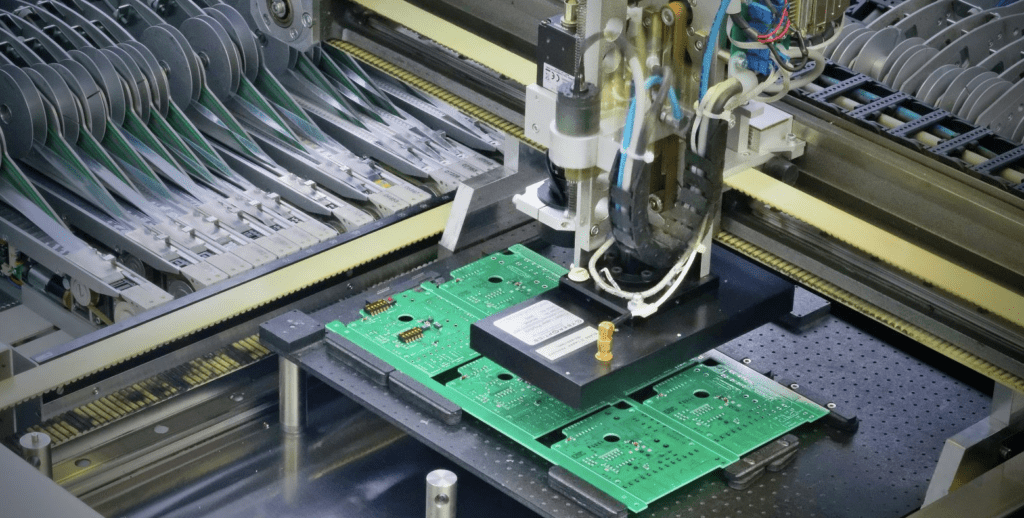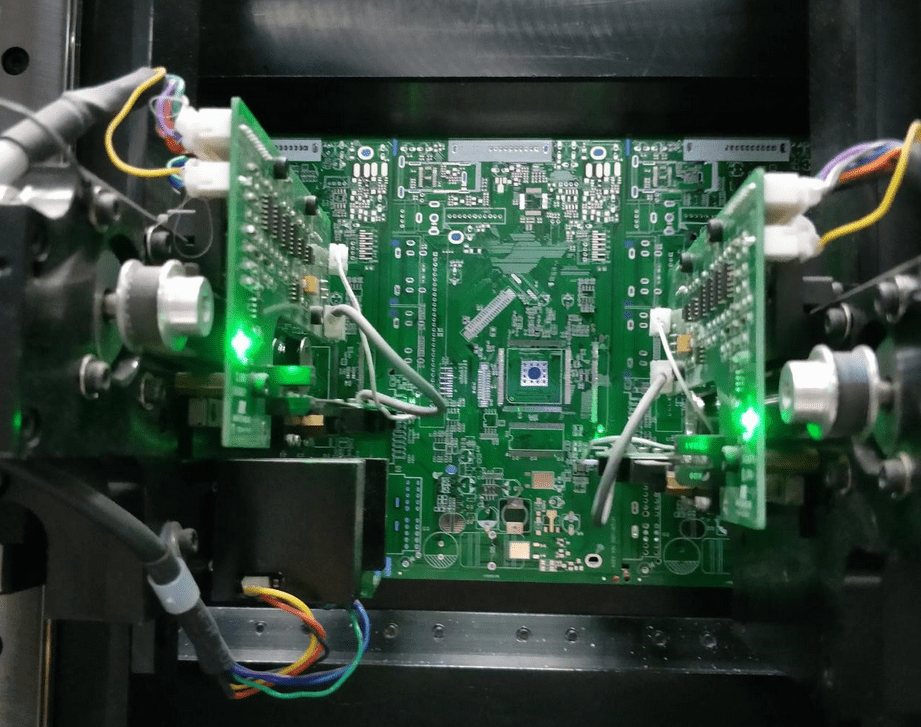Surface mount technology (SMT) is a method of creating electronic circuits in which the components are mounted directly onto the surface of a printed circuit board (PCB). This technology has revolutionized the electronics industry, providing a way to produce smaller, lighter, and more complex devices. SMT has replaced the through-hole method, which required the leads of components to be inserted into holes drilled into the PCB.
One of the main advantages of SMT is that it allows for a higher component density on a PCB, thus enabling the creation of smaller and more compact devices. This is because SMT components are much smaller than their through-hole counterparts, and they can be placed closer together on the board. Additionally, SMT components are typically faster and easier to assemble, which reduces manufacturing time and cost. SMT technology has become the standard in the electronics industry, and it is used in a wide range of products, from smartphones and laptops to medical devices and automotive electronics.

Overview
Surface mount circuit board (SMT) is a type of printed circuit board (PCB) that is widely used in electronic devices. It is a method of mounting electronic components onto the surface of the board, rather than inserting them through holes. This section will provide a brief overview of SMT, including its definition, advantages, and disadvantages.
Definition
SMT is a type of PCB that uses small, surface-mounted components instead of through-hole components. The components are mounted onto the surface of the board using a soldering process, which creates a strong and reliable connection between the component and the board. SMT components are typically smaller and lighter than through-hole components, making them ideal for use in compact and lightweight electronic devices.
Advantages
One of the main advantages of SMT is its size. Because the components are mounted on the surface of the board, the board itself can be smaller and more compact. This makes SMT ideal for use in small electronic devices, such as smartphones and tablets.
Another advantage of SMT is its speed and efficiency. SMT components can be mounted onto the board quickly and easily using automated machines, which can significantly reduce production time and costs. SMT also allows for a higher component density on the board, which can improve the performance and functionality of the device.
Disadvantages
One of the main disadvantages of SMT is its complexity. Because the components are mounted on the surface of the board, they can be more difficult to repair or replace if they fail. SMT components also require a higher level of precision during assembly, which can increase the risk of defects and errors.
Another disadvantage of SMT is its cost. Although SMT can be more efficient than through-hole assembly, it can also be more expensive due to the specialized equipment and expertise required for assembly.
Overall, SMT is a widely used and popular method of PCB assembly. Its small size, speed, and efficiency make it ideal for use in a wide range of electronic devices, although it does have some disadvantages that should be considered when choosing a PCB assembly method.
Design

When designing a surface mount circuit board, it is important to consider the components, layout, and assembly. Each of these factors plays a crucial role in the success of the final product.
Components
Choosing the right components is key to creating a functional and reliable circuit board. When selecting components, it is important to consider their size, power requirements, and compatibility with other components. It is also important to choose components from reputable manufacturers to ensure quality and reliability.
Layout
The layout of a circuit board can greatly impact its performance. When designing the layout, it is important to consider the placement of components, the routing of traces, and the overall size and shape of the board. Proper layout can help minimize noise, reduce interference, and improve signal integrity.
Assembly
The assembly process is critical to ensuring the functionality and reliability of a circuit board. Proper assembly techniques, such as soldering, must be used to ensure that components are securely attached to the board. It is also important to test the board after assembly to ensure that it is functioning properly.
In conclusion, designing a surface mount circuit board requires careful consideration of components, layout, and assembly. By paying attention to these factors, you can create a high-quality circuit board that meets your needs and performs reliably.
Manufacturing
Process
Surface mount circuit board manufacturing is a process that involves several stages. The process starts with the design of the circuit board. The design is then transferred to a computer-aided manufacturing (CAM) software that generates a machine-readable file. The file is then used to program the surface mount machines.
The surface mount machines are used to place the components on the circuit board. The process involves applying a solder paste to the board and then placing the components on the board using the surface mount machines. The machines use a vision system to ensure that the components are placed correctly.
After the components are placed on the board, the board is heated in a reflow oven. The oven melts the solder paste, which then solidifies to form a permanent connection between the components and the board.
Equipment
Surface mount circuit board manufacturing requires specialized equipment. The equipment includes:
- Surface mount machines: These machines are used to place the components on the circuit board.
- Reflow ovens: These ovens are used to heat the board to melt the solder paste.
- Inspection equipment: This equipment is used to inspect the board for defects.
- CAM software: This software is used to generate the machine-readable file that is used to program the surface mount machines.
The equipment used in surface mount circuit board manufacturing is expensive. However, it is necessary to ensure that the boards are manufactured to a high standard.
In conclusion, surface mount circuit board manufacturing is a complex process that requires specialized equipment and software. The process involves several stages, including design, component placement, and reflow. The equipment used in the process is expensive but necessary to ensure that the boards are manufactured to a high standard.
Testing

Methods
Testing is an essential part of the surface mount circuit board manufacturing process. It ensures that the circuit board functions correctly and meets the required specifications. There are various methods used to test surface mount circuit boards, including:
-
Visual Inspection: This method involves inspecting the circuit board visually to ensure that all components are in the right place, correctly oriented, and free from damage.
-
Automated Optical Inspection (AOI): AOI uses a camera to inspect the circuit board for defects such as missing components, incorrect component orientation, and solder defects.
-
In-Circuit Testing (ICT): ICT involves testing the circuit board for functionality by applying electrical signals to the board and measuring the response.
-
Functional Testing: This method involves testing the circuit board in its intended environment to ensure that it functions correctly.
Challenges
Testing surface mount circuit boards can be challenging due to the complexity of the boards and the small size of the components. Some of the challenges include:
-
Access: Surface mount components are small and are often placed close together, making it difficult to access individual components for testing.
-
Test Points: Many surface mount components do not have test points, making it difficult to test them.
-
Test Coverage: It can be challenging to test all the components on a surface mount circuit board, especially those that are hidden under other components.
-
False Failures: Some testing methods can result in false failures, where a component is flagged as defective when it is not.
In conclusion, testing is an essential part of the surface mount circuit board manufacturing process. Various methods are used to test circuit boards, including visual inspection, AOI, ICT, and functional testing. However, testing surface mount circuit boards can be challenging due to the complexity of the boards and the small size of the components.
Applications

Surface mount circuit boards are used in various industries and applications. Here are some of the most common applications:
Consumer Electronics
The consumer electronics industry is one of the largest consumers of surface mount circuit boards. These boards are used in a wide range of products, including smartphones, laptops, gaming consoles, and televisions. The small size and high density of surface mount components make them ideal for compact and lightweight devices. Additionally, surface mount technology allows for faster and more efficient assembly, reducing production costs.
Industrial Electronics
Surface mount circuit boards are widely used in industrial electronics, including automation, control systems, and robotics. These boards are designed to withstand harsh environments, such as extreme temperatures, vibrations, and moisture. They are also highly reliable, ensuring that industrial equipment operates smoothly and efficiently. Surface mount technology allows for the integration of multiple components in a single board, reducing the overall size and weight of the equipment.
Aerospace
The aerospace industry relies heavily on surface mount circuit boards for avionics, communications, and navigation systems. These boards are designed to withstand the extreme conditions of space and high-altitude flight, including radiation, extreme temperatures, and vibration. Surface mount technology allows for the integration of complex circuits in a compact and lightweight package, reducing the weight and size of the equipment. Additionally, surface mount components are highly reliable, ensuring that the equipment operates safely and efficiently.
In summary, surface mount circuit boards are used in a wide range of applications, including consumer electronics, industrial electronics, and aerospace. The small size, high density, and reliability of surface mount components make them ideal for compact, lightweight, and high-performance devices.

